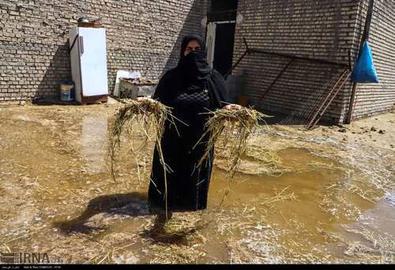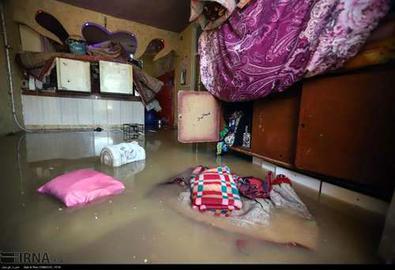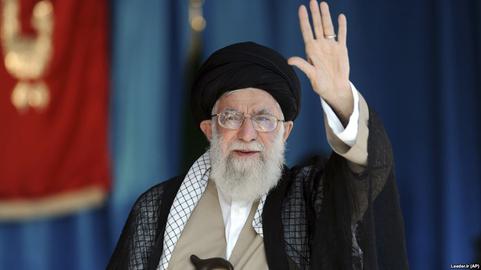On April 10, the retaining walls of Salman Canal collapsed, creating a nightmare for the people of the Eyn-e Do area outside Ahvaz, the provincial capital of Khuzestan.
Although Eyn-e Do, which spans an area of 7 km2 and has a population of 35,000, is not far from Ahvaz, it has historically been classified as a rural district, and was only incorporated as a district of Ahvaz in 2016. It is a poor neighborhood with a high population density.
Amid a countrywide flooding crisis that has hit dozens of provinces, city and provincial government officials all claimed that the situation in Ahvaz was under control, that there had been no need for evacuations and that relief workers were working day and night to help residents. But the people of Eyn-e Do denied these repeated claims, stating that eight main streets of the area were under water and residents had been evacuated from up to seven of them. Local relief workers also contradicted the claim that there had been no evacuations.
But the flooding in the oil-rich province of Khuzestan goes well beyond the Eyn-e Do neighborhood. According to state media, flooded areas of Ahvaz were being evacuated on Wednesday, April 9 and the official death toll from the flooding across Iran has reached 77. The Islamic Republic News Agency (IRNA) reported that more than 200 villages and towns were also evacuated in Khuzestan, and that 46,000 people had been housed in emergency shelters provided by the government.
Another source, the director of the provincial Red Crescent, reported that more than 102,768 people had been housed in emergency shelters and the Khuzestan Education Department said that many schools will be closed until April 15. The dam over the major river Karkheh has failed to hold back the huge levels of water, according to Fars News Agency. It is also reported that the cities of Susangerd, Bostan, Kut Seyyed Naeim, Rafi, Abu Homeyzeh and Hamidiyeh are in danger of being submerged by the floods.
“They treat us like illegal immigrants”
Abdel Aal Neysi, a local relief worker who lives on 10th Street in Eyn-e Do, says residents are resisting orders to evacuate. “People do not trust the government,” he says. “They believe that as long as this pile of wood and brick exists they can somehow manage to live, but if they lose it then they cannot put back together their lives in such poverty. The government is not going to give us loans so that we can restart from zero and rebuild our houses.” With bitter sarcasm he said that the whole family in a house would have to die before the government would do anything to help.
But Neysi has harsh words for his fellow citizens as well. “These days theft has gone up,” he says. “The thieves steal appliances, cars and the livestock of residents at night. How can they do this to their fellow countrymen? The government does not recognize us as citizens and treats us like illegal immigrants. Listen to what the provincial governor is saying. This is how the government people usually talk to us. We can at least be kind to ourselves. I don’t understand how, in the middle of disaster, a fellow countryman can come at night and rob you of everything you have!”
In Ahvaz, houses in the areas of Gol Dasht, Sayyahi, Sadat and Salim Abad have been submerged in water and if the floods continue the areas of Kian Shahr and Molashiyeh are also in danger of being submerged.
“People really only have themselves,” says Neysi. “Even the children are gathering stones and making sandbags with their bare hands. It was six days ago that Salman Canal broke and we were flooded. No help arrived until yesterday, when a group came and worked for a few hours but then, when they decided that it was no use, they gave up and went away. They brought a loader and a few mechanical shovels but nothing was done and they left them behind.”
Mismanagement Worse than Floods
Neysi says the people have suffered more from the government’s mismanagement than they have from the floods. “Some say that to save oil and gas installations, the government redirected the water toward residential areas and agricultural lands,” he says. “I don’t want to believe it, but why is nobody helping? Why do they take action against anybody who protests? Why do they still say that nothing is happening?”
On April 7, Ahvaz Mayor Mansour Katanbaf said that residents did not need to worry that their houses would be flooded because, according to Khuzestan’s Water and Power Organization, the Karun River’s outflow is “3,198 cubic meters and they are directing the water from Eyn-e Do to Salman Canal” [Persian link].
Salman Canal is an earthen canal north of Ahvaz, more than 100 kilometers long and around 100 meters wide. The brainchild of Mostafa Chamran, the first Islamic Republic’s Defense Minister, it was built during the 1980-1988 war so that it could be used to flood areas where Iraqi forces were positioned. After the war, according to the locals, it was left unused for many years until 2018, when another canal that carried drinking water from Karkheh River to Ahvaz collapsed and officials began using the Salman Canal to deliver the water supply. But soon enough, this canal started to collapse as well.
When the collapse of Salman started, says Neysi, “we reported that the canal was breaking up and water was getting into our farms. But they said: ‘Don’t worry. We will fix it fast!’”
No Lessons Learned
“Despite the authorities’ bad experiences with floods in northern Iran and in Lorestan, and despite that fact that there were accurate forecasts about precipitation in Khuzestan, they learned nothing about managing and monitoring dams’ floodgates or the right methods to evacuate cities in emergencies,” says Azam Bahrami, an environmental expert.
“When the dams, from Seimare Dam [in the province of Ilam] to levees over Kashkan [a flood-prone river in Lorestan province that flows into the Karkheh] overflowed, it was clear that areas downriver from Karkheh would be hit, especially since rains continued,” she says. “The higher-than-normal levels against the Dez [a major river in Khuzestan] Dam, even before the rains started, was not something that they or we did not know about. They repeated the error of not taking a risk with the dams’ floodgates and the provincial and the city governors issued conflicting news. All this made the situation more difficult for the people of Khuzestan.”
Bahrami points out that, before the situation became critical, local experts had recommended sites to set up shelters for people. “Unfortunately, this did not happen,” she says. “And neither were people provided with correct information. For instance, how are the people supposed to evacuate Susangerd and Ahvaz in an emergency? What routes are they supposed to take, or where can they find shelter? How should the evacuation of a city, an important consideration in the case of natural disasters, be conducted to minimize loss of life and property?”
She refers specifically to the evacuation of five areas of Ahvaz and a red alert issued for the evacuation of a sixth. She says the evacuations and notices were happening at the same time that the governor’s office was telling people not to pay attention to rumors and that no evacuation order had been issued. “Khuzestan’s governor and the head of the province’s Water and Power Organization said that the water was not over four meters above normal and that everything was under control,” says Bahrami. “They did not listen to us [when we said this was] a nonsense figure. They paid no attention to us.”
When asked about Salman Canal, Bahrami tells IranWire: “These canals played an important role in balancing the levels of water in the Karun and Karkheh rivers, but now they have turned into problems because they were not maintained and they were not dredged. No specific office in any ministry was responsible for them and, because of the shortage of funds, they were never included in bills for development.”
She adds that the problems are not limited to canals outside the cities. “On one hand, the sewage pipes are not enough for the population of Ahvaz,” says Bahrami. “On the other, all these pipes empty into the Karun River and since the Karun River has risen, the sewage flows back to the city. To this, add the fact that the rivers have not been dredged. Then, inside Karun’s basin, they have built buildings and artificial islands and these installations impede the flow of water.”
Azam Bahrami has been warning about such a situation on her Telegram channel for many months. “As of now,” she says, “hundreds of villages have been drowned, as has a hospital in Ahvaz and its industrial park. But there is no sign of the Ministry of Roads and Urban Development, nor of the army or the Revolutionary Guards. The locals says that some have taken a leave of absence from the military so they can join the people and help them. People are not ready to evacuate their homes. Throughout these years they have learned that they are alone and that they have nobody in times of disaster. They will not leave their homes.”
Related Coverage:
Zarif and Pompeo Exchange Insults and Accusations as Floods Continue, April 3, 2019
The Iran Floods and Ayatollah Khamenei’s Responsibilities, April 2, 2019
Iran’s Hurricane Katrina Moment, April 2, 2019
The Floods, the Foreign Conspiracy and Rouhani vs. the Guards, April 1, 2019
Iran Floods: What are the Government’s Legal Duties?, March 29, 2019
Rouhani Visits Devastated Areas as Floods Continue, March 28, 2019
Iran’s Budget for Religion 80 Times Higher Than Disaster Relief, March 28, 2019
As Environmentalists Perish in Prison..., March 26, 2019
Iran’s New Year Floods, March 25, 2019
visit the accountability section
In this section of Iran Wire, you can contact the officials and launch your campaign for various problems


























comments